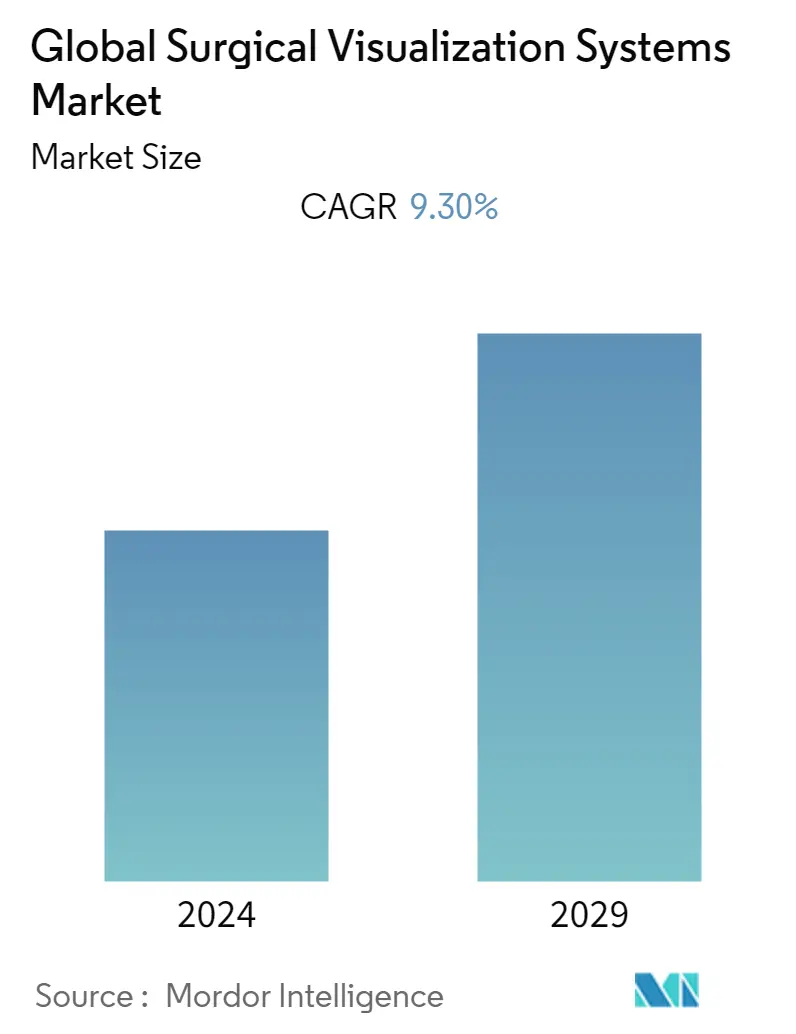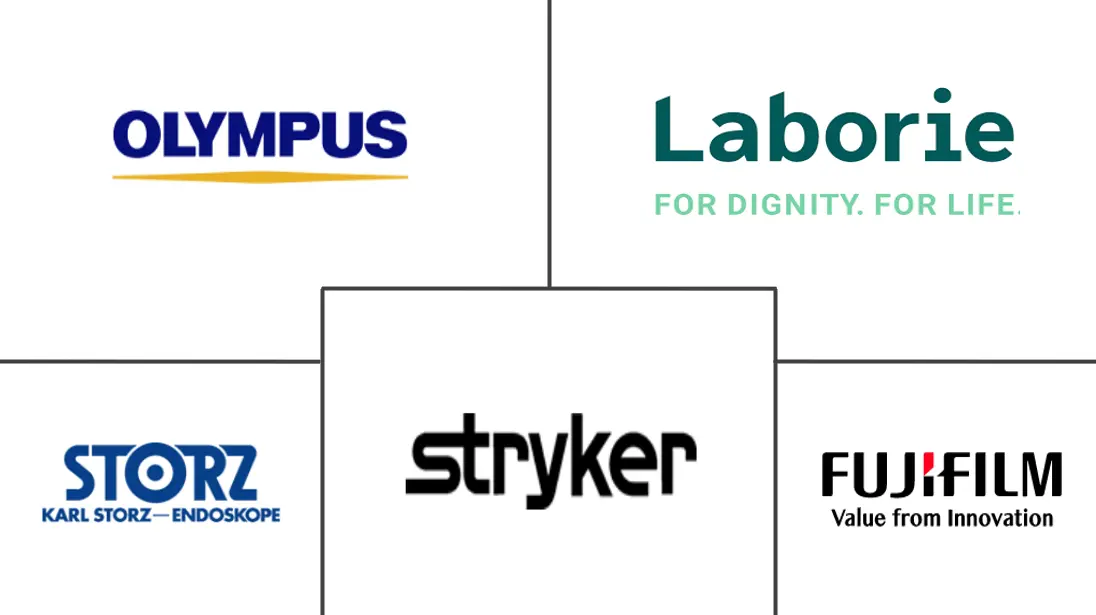Market Size of Global Surgical Visualization Systems Industry

| Study Period | 2019 - 2029 |
| Base Year For Estimation | 2023 |
| CAGR | 9.30 % |
| Fastest Growing Market | Asia Pacific |
| Largest Market | North America |
| Market Concentration | Low |
Major Players
*Disclaimer: Major Players sorted in no particular order |
Surgical Visualization Systems Market Analysis
During the time frame of the forecast, the surgical visualization systems market is expected to grow at a CAGR of nearly 9.3%.
COVID-19 affected the surgical visualization system market. For instance, an article published in the November 2020 issue of the National Library of Medicine reported thousands of endoscopies are performed annually, but during the COVID-19 pandemic period, a significant decline in these procedures was observed across the globe. Thus, although an overall reduction in elective and urgent procedures was observed, which impacted the growth of the studied market, after a few months the market witnessed significant growth as these services were resumed. In addition, according to the study published in the February 2022 issue of the National Library of Medicine, while surgical services were temporarily shut down during the initial COVID-19 surge, the healthcare system continued to offer safe care for gastrointestinal surgery patients, especially those with oncologic reasons. There has been a comeback in surgical volume and patient mix since the phased reopening, which has finally lessened the initial detrimental impact of the pandemic on the provision of gastrointestinal surgical treatment. Such studies show the rise in surgical procedures, which may drive the market's growth post-pandemic.
The factors that are supposed to be propelling this market are the increasing prevalence of chronic diseases and technological advancements in devices. The increasing prevalence of chronic diseases like cancer and chronic kidney disease (CKD) requires constant diagnosis and frequent hospital visits, which is propelling the demand for surgical visualization systems and thereby contributing to the growth of the studied market. For instance, in July 2022, the Center for Disease Control and Prevention (CDC) published a report that reported that in 2021, 1 in 7, which is about 15% of United States adults or 37 million people, is estimated to have chronic kidney disease (CKD). The report also stated that chronic kidney disease (CKD) is more common in women than in men. Thus, the high incidence of chronic disorders is associated with a high demand for surgical procedures, thereby driving the growth of the studied market.
The technological development of various surgical instruments is also propelling the growth of the studied market. For instance, in November 2021, Medtronic plc launched its PillCam Small Bowel 3 system for remote endoscopy procedures. The PillCam SB3 at Home program combines Medtronic's PillCam technology with Amazon logistics, a combination intended to ensure both timely and accurate results for patients from the comfort of their homes. In April 2022, SonoScape Medical Corp. got approval from the US Food and Drug Administration (USFDA) for its video endoscopy system HD-550, which is used to diagnose problems in the gastrointestinal tract.
Thus, due to the aforesaid factors, such as increasing chronic diseases and product launches, the market is expected to witness significant growth over the forecast period. However, the high cost of endoscopy procedures may slow down the growth of the studied market.
Surgical Visualization Systems Industry Segmentation
As per the scope of the report, surgical visualizations are the systems that are generally used in operating rooms during surgical procedures. It helps surgeons see efficiently, which results in better outcomes. The surgical visualization systems reduce the reflections and increase the usable contrast ratio, which further helps in the visualization of the body during surgeries. The Surgical Visualization Systems Market is segmented by product (endoscopic cameras, light sources, displays and monitors, video recorders, and accessories), application (gastroscopy, endoscopy, colonoscopy, and other applications), end-users (hospitals, diagnostic imaging centers, and other end-users), and geography (North America, Europe, Asia-Pacific, the Middle East and Africa, and South America). The market report also covers the estimated market sizes and trends for 17 countries across major regions globally. The report offers the value (in USD million) for the above segments.
| By Product | |
| Endoscopic Cameras | |
| Light Sources | |
| Displays and Monitors | |
| Video Recorders | |
| Accessories |
| By Application | |
| Gastroscopy | |
| Colonoscopy | |
| Endoscopy | |
| Other Applications |
| By End-Users | |
| Hospitals | |
| Diagnostic Imaging Centers | |
| Other End-Users |
| Geography | ||||||||
| ||||||||
| ||||||||
| ||||||||
| ||||||||
|
Global Surgical Visualization Systems Market Size Summary
The surgical visualization systems market is poised for substantial growth over the forecast period, driven by the increasing prevalence of chronic diseases and advancements in medical technology. The market experienced a temporary setback due to the COVID-19 pandemic, which led to a decline in surgical procedures. However, the resumption of services and the rise in surgical volumes have mitigated the initial negative impact. The demand for surgical visualization systems is being propelled by the need for constant diagnosis and frequent hospital visits for chronic conditions such as cancer and chronic kidney disease. Technological innovations, such as remote endoscopy systems and AI-assisted colonoscopy technologies, are further enhancing the market's growth prospects. Despite the high cost of endoscopy procedures posing a challenge, the overall trend indicates a positive trajectory for the market.
Regionally, North America is expected to witness significant growth, supported by a robust healthcare infrastructure, the presence of key industry players, and a high prevalence of chronic diseases. The region's market expansion is also fueled by beneficial government initiatives and increased research collaborations. The high incidence of colon and rectal cancers in North America, particularly in the United States, is a major factor driving market growth. The competitive landscape is characterized by a fragmented market with both international and local companies, including prominent players like Olympus Corporation, Stryker Corporation, and Fujifilm Corporation. These companies are actively engaging in product launches, technological developments, and strategic partnerships to strengthen their market positions.
Global Surgical Visualization Systems Market Size - Table of Contents
-
1. MARKET DYNAMICS
-
1.1 Market Overview
-
1.2 Market Drivers
-
1.2.1 Increasing Prevalence of Chronic Diseases
-
1.2.2 Technological Advancements in the Devices
-
-
1.3 Market Restraints
-
1.3.1 High Cost of Endoscopy Procedures
-
-
1.4 Porter's Five Forces Analysis
-
1.4.1 Threat of New Entrants
-
1.4.2 Bargaining Power of Buyers/Consumers
-
1.4.3 Bargaining Power of Suppliers
-
1.4.4 Threat of Substitute Products
-
1.4.5 Intensity of Competitive Rivalry
-
-
-
2. MARKET SEGMENTATION (Market Size by Value - USD million)
-
2.1 By Product
-
2.1.1 Endoscopic Cameras
-
2.1.2 Light Sources
-
2.1.3 Displays and Monitors
-
2.1.4 Video Recorders
-
2.1.5 Accessories
-
-
2.2 By Application
-
2.2.1 Gastroscopy
-
2.2.2 Colonoscopy
-
2.2.3 Endoscopy
-
2.2.4 Other Applications
-
-
2.3 By End-Users
-
2.3.1 Hospitals
-
2.3.2 Diagnostic Imaging Centers
-
2.3.3 Other End-Users
-
-
2.4 Geography
-
2.4.1 North America
-
2.4.1.1 United States
-
2.4.1.2 Canada
-
2.4.1.3 Mexico
-
-
2.4.2 Europe
-
2.4.2.1 Germany
-
2.4.2.2 United Kingdom
-
2.4.2.3 France
-
2.4.2.4 Italy
-
2.4.2.5 Spain
-
2.4.2.6 Rest of Europe
-
-
2.4.3 Asia-Pacific
-
2.4.3.1 China
-
2.4.3.2 Japan
-
2.4.3.3 India
-
2.4.3.4 Australia
-
2.4.3.5 South Korea
-
2.4.3.6 Rest of Asia-Pacific
-
-
2.4.4 Middle East and Africa
-
2.4.4.1 GCC
-
2.4.4.2 South Africa
-
2.4.4.3 Rest of Middle East and Africa
-
-
2.4.5 South America
-
2.4.5.1 Brazil
-
2.4.5.2 Argentina
-
2.4.5.3 Rest of South America
-
-
-
Global Surgical Visualization Systems Market Size FAQs
What is the current Global Surgical Visualization Systems Market size?
The Global Surgical Visualization Systems Market is projected to register a CAGR of 9.30% during the forecast period (2024-2029)
Who are the key players in Global Surgical Visualization Systems Market?
Olympus Corporation, Stryker Corporation, Fujifilm Corporation, Karl Storz GmbH & Co. Kg. and Laborie Inc. are the major companies operating in the Global Surgical Visualization Systems Market.

